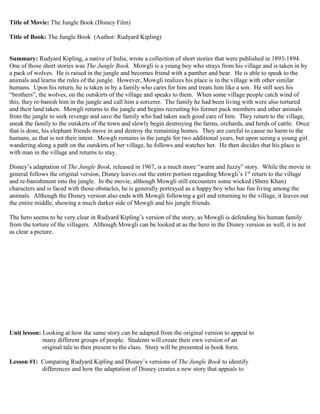
TheJungleBookandwritingtoanaudience-1.docx
- 1. Title of Movie: The Jungle Book (Disney Film) Title of Book: The Jungle Book (Author: Rudyard Kipling) Summary: Rudyard Kipling, a native of India, wrote a collection of short stories that were published in 1893-1894. One of those short stories was The Jungle Book. Mowgli is a young boy who strays from his village and is taken in by a pack of wolves. He is raised in the jungle and becomes friend with a panther and bear. He is able to speak to the animals and learns the rules of the jungle. However, Mowgli realizes his place is in the village with other similar humans. Upon his return, he is taken in by a family who cares for him and treats him like a son. He still sees his “brothers”, the wolves, on the outskirts of the village and speaks to them. When some village people catch wind of this, they re-banish him in the jungle and call him a sorcerer. The family he had been living with were also tortured and their land taken. Mowgli returns to the jungle and begins recruiting his former pack members and other animals from the jungle to seek revenge and save the family who had taken such good care of him. They return to the village, sneak the family to the outskirts of the town and slowly begin destroying the farms, orchards, and herds of cattle. Once that is done, his elephant friends move in and destroy the remaining homes. They are careful to cause no harm to the humans, as that is not their intent. Mowgli remains in the jungle for two additional years, but upon seeing a young girl wandering along a path on the outskirts of her village, he follows and watches her. He then decides that his place is with man in the village and returns to stay. Disney’s adaptation of The Jungle Book, released in 1967, is a much more “warm and fuzzy” story. While the movie in general follows the original version, Disney leaves out the entire portion regarding Mowgli’s 1st return to the village and re-banishment into the jungle. In the movie, although Mowgli still encounters some wicked (Shere Khan) characters and is faced with those obstacles, he is generally portrayed as a happy boy who has fun living among the animals. Although the Disney version also ends with Mowgli following a girl and returning to the village, it leaves out the entire middle, showing a much darker side of Mowgli and his jungle friends. The hero seems to be very clear in Rudyard Kipling’s version of the story, as Mowgli is defending his human family from the torture of the villagers. Although Mowgli can be looked at as the hero in the Disney version as well, it is not as clear a picture. Unit lesson: Looking at how the same story can be adapted from the original version to appeal to many different groups of people. Students will create their own version of an original tale to then present to the class. Story will be presented in book form. Lesson #1: Comparing Rudyard Kipling and Disney’s versions of The Jungle Book to identify differences and how the adaptation of Disney creates a new story that appeals to
- 2. a different group of people. After reading Rudyard Kipling’s The Jungle Book, and watching Disney’s The Jungle Book, we will begin a unit about audience and writing to appeal to a particular age group, ethnicity, or gender. Lesson Plan: Age group: 9th – 10th Background: Class will have read The Jungle Book and watched the Disney version and discussed in class. Objective: Students will be able to display the understanding of writing to an audience by taking an original fairy tale of their choosing, identifying a group of people they would like to write for, and adapt the original into their own version. Classroom Activities: o Review purpose of a Venn Diagram o Students will be placed in groups and each person given a Venn diagram to compare and contrast the versions of The Jungle Book (10-12 mins) o One person from each group will be asked to come to the board and give 1 example of a comparison and contrast (10-12 mins) o Students will return to their seats and as a class we will discuss and list how each version could potentially be geared towards a different age group and give some examples (6-7 mins) o Students will be given a list of fairy tales and will be asked to choose one they would like to adapt to appeal to a different group of people and then given a summary of the story they have chosen Homework: Students will be given a graphic organizer to take home, decide who they are writing for and begin brainstorming adaptations they can make from the original version